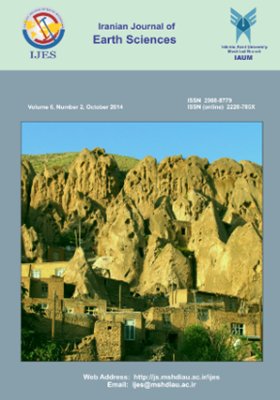Determination of Travertine Outcrop Types in Tazerj (Northern Hormozgan) using Mineralogical and Geochemical Data
Subject Areas : MineralogyJamal Tarrah 1 , Zahra Abedpour 2 * , Seyed Mohammad Mirhosseini 3
1 - Islamic Azad University, Bandar Abbas Branch, Geology Department, Bandar Abbas, Iran.
2 - Islamic Azad University, Bandar Abbas Branch, Iran
3 - University of Applied Science and Technology, Bandar Abbas ACECR Center, Iran
Keywords: Travertine, calcite, tectonic, metogene, Tazerj,
Abstract :
The Tazerj travertine deposits are located 25 km northwest of Haji Abad and 5 km northeast of Tazerj Village in Hormozgan Province, southern Iran. This area is part of the Folded Zagros Zone. The studied travertine deposits are located on Eocene deposits and were most likely formed through the dissolution and re-deposition of groundwater and atmospheric waters onto the Asmari limestone. The petrographic evidence shows calcite to be the dominant mineral forming the microscopic sections of the Tazerj travertine deposits. The textural characteristics of the sediments confirm that microbial and biological activity was present at the time of deposition. XRD results confirm the existence of calcite-type calcium carbonate. In addition, XRF results confirm low levels of strontium and relatively high levels of magnesium. Finally, the geological evidence indicates that the rocks were created as a result of tectonic activity. The circulation of atmospheric deep water and its reappearance on the ground as hot springs through fractures and faults, formed meteogenic travertine deposits in Tazerj along large faults and fractures. The temperature of the hot springs responsible for creating the travertine deposits is estimated at approximately 30 °C.

